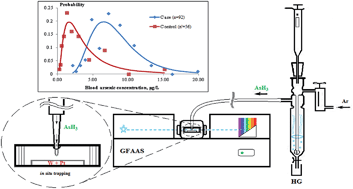Biological monitoring of arsenic pollution based on whole blood arsenic atomic absorption assessment with in situ hydride trapping†
Abstract
A digestion-free blood arsenic assessment method based upon in situ trapping of arsenic hydride in coated graphite furnace was developed. Double layer coating of the furnace with Na2WO4–H2PtCl6 was used. Arsenic limit of detection (3σ) for whole blood samples was 0.1 μg L−1. Dynamic range was 60–1000 pg As. Relative standard deviation for blood samples (n = 3) was 7–13%. Blood arsenic biomonitoring in infants residing in an industrially polluted area was performed using the designed method. Whole blood arsenic determination was performed in 92 subjects of case group and 56 subjects of age-matched control group. For both groups observed, blood arsenic distribution was found to be close to lognormal. Lognormalized mean blood arsenic for the case group was 5.89 ± 1.31 μg L−1, whereas for controls it was 1.50 ± 2.26 μg L−1. Significant blood arsenic elevation was observed in the case group of the infants under study as compared to the controls and previously published data.



 Please wait while we load your content...
Please wait while we load your content...